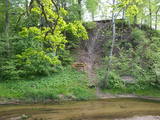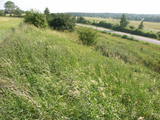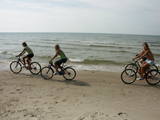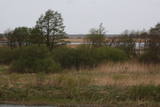| Nr | Name | Beschreibung |
|---|---|---|
|
The first barefoot trail created in the Baltic States in the recreation complex "Valguma pasaule", which is located on the forested shores of Lake Valguma. When walking on the path, the feet "massage" sand, wood chips, clay, peat, gravel, cones and various other materials. |
||
|
This is part of a hiking trail along the Cena bog. It is on the western side of the bog, at the centre of the 5-kilometre circular trail. You can see the vast swamp, as well as a military road that was installed during World War I and is marked by an “alley” of large pine trees. Alongside the tower is a fragment of the road that was installed more recently.
|
||
|
Dieses Gebiet befindet sich auf beiden Seiten des mittleren Abschnitts des Flusses Raķupe. An den Ufern des Flusses gibt es sowohl viele verschiedene Wiesenbiotope als auch mächtige Eichen. Das ist ein wichtiger Platz für seltene Pflanzen und Tiere.
|
||
|
The rock is along the main street of Krāslava and is found at Augusta Street 12. After major reconstruction of the city’s infrastructure, the rock was successfully integrated into the surrounding landscape. The rock is 2.8 m long, 2.2 m wide and 700 cm high. It once served as a border stone for the village of Krāslava. It was placed there in 1729 to commemorate the day when the noble Plater dynasty bought Krāslava. The dynasty’s seal is engraved in the side of the rock along with the date when it was installed. Legend has it that Polish King Augustus II dined at the rock after a hunt, and that is why it is known as Augustus’ Rock. |
||
|
One of the rare places (see also Rucavas ivju audze) in Latvia where two rare and protected wild tree species grow - yew-tree and Baltic ivy. Territory is not marked on site with information signs or stands therefore it is hard for visitors to find. Not usable as tourism object.
|
||
|
This is an unusually shaped pine which, according to legend, was planted by the king of Sweden during the Great Northern War.
|
||
|
Der Schlosspark Žagarė ist einer der prunkvollsten und aus architektonischer Sicht einer der interessantesten in Litauen. Der Park wurde 1898-1900 rekonstruiert und dabei nach einem Entwurf des berühmten Gartenarchitekten Georg Kuphaldt erweitert. Im Park wurden mehr als 200 Arten Pflanzen angepflanzt. Davon wachsen über 100 auch heute noch. Eine Vielzahl an Wegen und Pfaden sind im Park erhalten, auf denen man die Größe und Schönheit des Parks eindrücklich empfinden kann. In dem Park gibt es einen dendrologischen Lehrpfad, wo 15 seltenere Baumarten markiert und beschrieben sind. |
||
|
Der größte Teil dieses geschützten Territoriums besteht aus einem flachen und eutrophischen Wassergebiet, in dem viele Vogelarten nisten, darunter einige seltene und geschützte. Spezialisten meinen, dass hier zwischen 150 und 450 Paare der Lachmöwe regelmäßig nisten.
|
||
|
Taka izveidota 2005. gadā. Tā atrodas uz Lapmežciema un Bigauņciema robežas un izskatās kā koka dēlīšu laipa gar Siliņupi. Taka aizved līdz jūrai, kur apskatāms vecais Lapmežciema mols. Siliņupē novērojami ūdensputni. |
||
|
The Boulder of Subinaite can be found in Sakstagala rural municipality opposite Vaļenieku House that
is on the left side of the river Rēzekne. The base of the boulder is below the river level; it is 5,2 m long, 4,4
m wide, it rises about 1,6 m above the water level, about 2,5 m below the water level, capacity 26 m3.
Reddish surface is heavily eroded and full of moss. Protected since 1977.
|
||
|
72 types of wild rhododendrons with 193 different species
This is the only specialised rhododendron nursery in the Baltic States. Specialists there work on different kinds of rhododendrons, seeking to produce decorative and winter-resistant types of the flower. The nursery also sells plants. In the facility’s pine forest, which covers 11.8 hectares, you can see a large collection of rhododendrons from all over the world.
There are 64 winter-resistant types of rhododendrons at “Babīte,” including “Alma Mater,” “Academia Scientiarum,” “Emeritus,” “Eduards Smiļģis,” “Dita Krenberga,” and others (these were developed by Rihards Kondratovičs). All of these are appropriate for Northern Europe.
|
||
|
Established in 1900 at the place where the Pērse River flows into the Daugava (now the reservoir of the Pļaviņas hydroelectric power plant), the park offers a look at 17th century Swedish cannons and monuments from Medieval graves. Next to the high school in the park is a restored fountain, “Head of a Faun,” which was near the legendary Pērse waterfall during the 1930s. The waterfall is now underwater, but its location is indicated by a stone sculpture, “Girl of Pērse,” which was created by the sculptor Juris Zihmanis. A path leads to an 11 metre high wooden sculpture, “For Eternity,” by the sculptor Ģirts Burvis, and another sculpture, “Little Owl,” which is the work of the Rurāns brothers, both of whom are sculptors of wooden sculptures.
|
||
|
Der Vilce Naturpark ist klein und verläuft entlang der tiefen Tälern des Vilce - Flusses und seinen Nebenflüssen. Die Biotope umfassen Sandsteinklippen, Stromschnellen, Wälder, die für solche Gegenden typisch sind und die entsprechenden Pflanzen und Tiere darin. Der gut hergerichtete Burgberg von Vilce liegt neben der Zaķu-Wiese, die ein hübsch gestalteter und beliebter Platz zum Ausruhen ist.
|
||
|
The classical skyline of Old Rīga can be enjoyed from several locations – Mūkusalas Street, between the railroad bridge and the stone bridge, from the stone bridge, from the A-B dam, from the grounds of the central office of the Swedbank bank, from the Vanšu bridge, and from the Ballast Dam at Ķīpsala. You can hike or bike from location to location. During the summer, little ships cruise up and down the Daugava to offer different views.
|
||
|
Dieses Territorium schützt die Küste des ehemaligen Baltischen Eismeeres, das sich über mehrere Kilometer auf der östlichen Seite der Straße Grobiņa-Ventspils erstreckt. Von einem hohen Punkt der alten Küste hat man einen schönen Blick auf die Piejūra – Tiefebene, leider gibt es keinen speziellen Aussichtturm. Geschützte Arten und Biotope sind in diesem Territorium vorhanden.
|
||
|
Eins der eindrücksvollen Meteoritenkraterfelder Europas. Der Hauptkrater ist 22 m tief, Durchmesser – 110 m. Der ungefähre Zeitraum des Meteoriteneinschlags liegt ung. 7500-Jahre zurück. |
||
|
Elka Hill is one of the highest surfaces in the western part of the Vidzeme highlands, and it offers a lovely and broad view to the North. There is a small parking lot, a TV and radio tower, and the place where the Gauja River is thought to originate.
|
||
|
Das geschütze Meeresgebiet „Nida – Pērkone“ ist ein von den biologisch vielfältigsten und für den Naturschutz wichtigsten Meeresgebieten an der offenen Küste der Ostsee. Hier kann man die hervorragendsten Riffe anfinden. Während der Vogelmigration wird das Territorium vom größten Teil der in Lettland festgestellten migrierenden Vogelarten überquert. Das Gebiet ist besonders wichtig zum Schutz vom Gänsesäger und der Zwergmöwe. Es befindet sich gegenüber der Regionen Rucava und Nīca. Die Fläche beträgt 36 703 ha. Das Gebiet überdeckt sich Teilweise mit dem Meeresgebiet vom Naturpark „Pape“ und enthält das Meeresgebiet vom Naturpark „Bernāti“.
|
||
|
Sedas purva kājnieku maršruts atrodas dabas liegumā Sedas purvs, pārgājienu pa maršrutu iespējams apvienot ar Sedas pilsētas apskati, kas ir unikāls 20.gs. 50.–60. gadu pilsētbūvniecības un arhitektūras paraugs - kūdras purva strādnieku pilsēta. Maršrutam ir divi apļi - Jērcēnu aplis - 5,5 km un Sedas aplis - 4,2 km. Tajos apakatāms izstrādātais kūdras purvs, šaursliežu dzelzceļš, ritošais sastāvs, divi skatu toņi. Rudenī un pavasarī - putnu migrācijas lāikā - interesanta vieta putnu vērošanai. GPS koordinātes: Jērcēnu puses aplim: 57.7055987, 25.7001324; Sedas puses aplim: 57.6699587, 25.7514815. |
||
|
Im Zentrum dieses Schutzgebietes befindet sich der eutrophische See Tosmare, eine ehemalige Lagune des Litorina – Meeres. Der See und seine Umgebung bietet vielen Pflanzen und Vögeln Schutz. Am südlichen Ende des Sees kann man Überreste des ehemaligen Befestigungssystems von Liepāja entdecken, nach Westen hin befindet sich einer der wichtigsten Teile des Systems – der Festungskanal.
|
||























